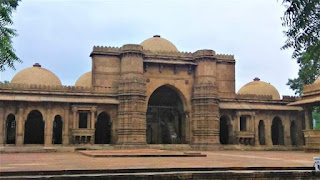 |
| DADA HARIR NI VAV(STEPWELL) |
DADA HARIR NI VAV
 |
| DADA HARIR NI VAV(STEPWELL) |
 |
| DADA HARIR NI VAV(STEPWELL) |
Hisorty of Dada harir ni vav
 |
| DADA HARIR NI VAV(STEPWELL) |
Architecture of Dada harir ni vav
Dada Harir ni Vav has seven stories, every one similarly radiant in its magnificence. Set apart by complicatedly cut dividers, sections, and columns, the stepwell looks brilliant during the daytime when you can see the work. The design style of this vav is a mélange of both Muslim and Hindu styles. You will likewise track down Arabic and Sanskrit sacred writings on the dividers alongside flower themes and customary carvings.
A great many people get their photos clicked while remaining on the railing sitting above the vav beneath. The stepwell is octagonal and it is an astounding sight to peer down from the popular narrative of the flight of stairs. Similarly exciting is going down every one of the means and gazing upward, while the daylight channels in from the focal point of the vav. Beneath the railing of each floor, at the piece sticking out, there is a plan that resembles an archway or hanging of stone.
What adds to the old world appeal of this stepwell is the haze of bats who choose to make their terrific entry from the niches behind the dividers and columns. The winding flight of stairs and the arrival region at each level are adequately large to oblige a lot of individuals.
There are air and light vents in the rooftops at every one
of the floors and furthermore at the arrival level. Due to these openings at
different spots you don't feel claustrophobic by any stretch of the imagination
anytime. From the primary story level, three flights of stairs lead to the most
minimal level of the stepwell and this is a captivating component of this
stepwell.
Places to see near dada harir ni vav
1. Mata Bhavani ni Vav:
This is the second stepwell of Ahmedabad and is at a mobile separation from Dada Harir ni Vav. Dissimilar to Dada Harir ni Vav, the engineering style of this stepwell mirrors the impact of Hindu culture. The lower exhibition of this vav has a sanctuary of Mata Bhavani.
 |
| MATA BHAVANI MANDIR |
This vav isn't anything less in excellence when contrasted with Dada Harir ni Vav. Individuals by and large visit both these stepwells together as they are very near one another. This vav was worked during the reign of the Solanki line in the eleventh century.
Individuals visiting both these stepwells notice one more
distinct contrast between the two. Where Dada Harir ni Vav may appear to be a
little dull and shabby, nearly lost in the pages of time, Mata Bhavani n Vav
gives out an energetic, beautiful and exuberant energy.
Models and puppets here are portraying significant scenes
from strict Hindu sacred texts. One such scene is the place where Lord Krishna
is being conveyed in a tempest in the arms of his dad. Rebuilding work was
attempted on this vav and for that reason it is in much preferred shape over
Dada Hari ni Vav.
2. Sultani Mosque:
Sultani mosque is said to have been
worked around a similar time as Dada Harir ni Vav, which is 1500 AD. This mosque
is home to the burial chamber of Bai Harir who assembled Dada Harir ni Vav and
is found right behind the stepwell. The mosque was worked by Bai Harir's child
as a recognition to his mom.
 |
| SULTANI MOSQUE |
There are five burial places in this mosque and the building
work here mirrors the meticulousness given by craftsmans of that time. The
complicated jali work on the windows of this mosque isn't simply wonderful to
take a gander at yet additionally acquires daylight inside the mosque.
3. Akshardham sanctuary:
 |
| AKSHARDHAM SANCTUARY |
Also known as the Swaminarayan
sanctuary, Akshardham sanctuary gives proper respect to Lord Narayan Dev. It
was underlying the year 1822 compelled of Swaminarayan, the originator of the
Swaminarayan faction of Hinduism. The sanctuary additionally portrays the
individual parts of Swaminarayan's life and the morning and evening aartis here
are gone to by an enormous number of lovers.
